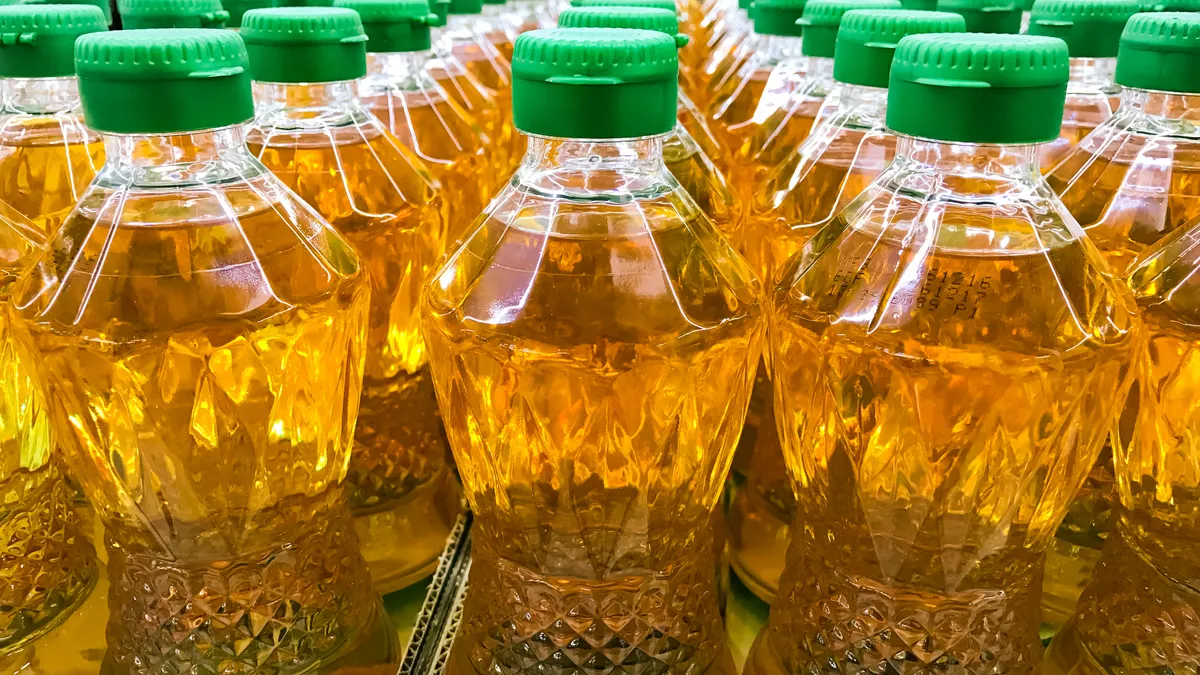Indonesia’s decision to ban palm oil exports this week is having real consequences to the supply and price outlook for edible oils.
The Southeast Asian nation on Thursday began imposing an export ban on palm oil — one that has repeatedly changed in scope within the past week. On April 22, the government initially said it would ban all palm oil exports beginning April 28 in an effort to ease local prices and supply for the food commodity. Over the weekend, it narrowed the ban to refined, bleached and deodorized (RBD) palm olein, a processed version used as a cooking oil. But on Wednesday, Indonesia again widened the ban to include all crude and refined palm oil.
Each announcement sent palm oil futures prices soaring or sinking, and along with it prices for soybean oil, a popular alternative.
Although Indonesian authorities said the export ban would continue until domestic availability and affordability of palm oil improved, analysts expect it to be only a matter of weeks before the country reverses course.
“They produce roughly 45 million metric tonnes of palm oil annually and consume only about 16.5 million metric tonnes domestically. This policy should force domestic prices down to the cap. Once that happens, exports will resume as normal,” said Paul Hughes, chief agricultural economist and director of research at S&P Global Commodities Insights, Agribusiness, in emailed comments. Once the ban begins, "storage will fill up quickly," he noted.
“I mean, what are they going to do — swim in it?” asked Michael Swanson, chief agricultural economist with Wells Fargo. Swanson sees the export ban as a political move meant to assuage consumer anger over food inflation. He believes Indonesia's palm oil producers and processors, who want to sell their products to the highest-paying and biggest buyers in the world, will pressure the government to end the export ban quickly.
In the meantime, the export ban is having an effect on the price for palm and other edible oils, with no clear means to relieve the pressure.
Tim Luginsland, sector manager of grain and oilseeds for Wells Fargo’s Food & Agribusiness Industry Advisors group, said there are no comparable alternative sources for palm oil. Indonesia supplied 58% of the market in 2019, according to Statista, followed by Malaysia at 26%.
“Malaysia is the quick answer, but unfortunately, they are dealing with their own labor and transportation issues, so they won’t solve the issue,” he said via email.
Substitutes for the popular cooking oil are also not an immediate fix. Palm oil made up 37% of edible oil production in 2020, according to figures shared by Wells Fargo’s Swanson. Soybeans supplied another 31%. But supplies of soybeans have been pressured by a drought in Argentina, the top global exporter of the crop. In March, the South American country made its own protectionist move by raising export taxes on soybean oil and briefly suspended exports after Russia invaded Ukraine.
Soybean oil Chicago futures hit a record high this week and are up 27% compared to a year ago, according to Gro Intelligence. Prices for oilseed crops such as canola and corn have also rallied.
“So there's really no place to run and hide from soybeans or palm oil,” said Swanson.
War and biofuel mandates are also eating into available edible oil supply. Sunflower oil, one potential substitute, has faced pressure throughout the war between Ukraine and Russia, which combined supply 80% of the world market.
Meanwhile, demand from the biofuels industry is also competing with food for tight edible oils supply.
“Biofuels policies play a very big role in the price escalation of all vegetable oils,” said Hughes with S&P Global. In the United States, federal mandates require oil refiners to blend a steadily increasing percentage of biofuels into gasoline and diesel each year. “While many of the policies within North America essentially preclude the use of palm oil in these low-carbon fuel standards, these policies raise the price of other oils and fats, which pushes demand for palm oil and indirectly raise its price,” Hughes said.
No easy replacements
For the food industry, decisions will need to be made, although none will be easy.
“Many food manufacturers are already facing double-digit inflation and one supply issue after another. Palm oil is a very widely used ingredient that replaces butter/milkfat in a number of products," said Tom Bailey, senior consumer foods analyst with Rabobank, via email. "Palm oil is also used as a low-cost and tasty ingredient for many other products, which could have an impact on some of the more affordable, low-priced options that consumers were counting on."
For now, analysts advise that edible oil buyers focus on diversifying their sources.
“The best option is flexibility of supply,” said Hughes. “The price spreads of these oils are constantly in flux. The ability to be nimble and switch origins, even switching the oils used” will be key.
Mondelēz International, maker of Oreo cookies and Ritz crackers, makes up for 0.5% of global palm oil consumption, according to its website, and sources most of its supply from Indonesia and Malaysia. In the company's first-quarter earnings call this past Tuesday, CFO Luca Zaramella described the Indonesian export ban as "not a material issue at this point in time," before adding, "We are clearly monitoring the situation very closely."
“The best option is flexibility of supply. The price spreads of these oils are constantly in flux."

Paul Hughes
Chief agricultural economist and director of research, S&P Global Commodities Insights
Juan Luciano, CEO of edible oils supplier Archer Daniels Midland, described Indonesia's export ban in the company’s first-quarter earnings call on Tuesday as “a short-term palliative for their domestic inflation." He acknowledged that the balance between supply and demand is "very tight." However, ADM has "seen the opportunity to add a lot of value to some of the customers that are looking for replacements at this point in time" by assisting with reformulations.
But for food manufacturers, the ability to quickly substitute oils is not straightforward. Swanson notes that beyond finding a suitable replacement for palm oil, they would also need to contend with changing ingredient labels.
“Unfortunately ingredient labels are sometimes more of a straight jacket than anything else,” he said. “Do you really want to go and try to reformulate and change all that information on what was probably several quarters of a supply issue? And the answer is 'no.'"























